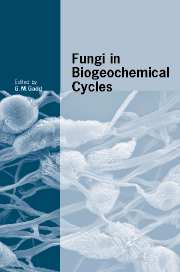Book contents
- Frontmatter
- Contents
- List of Contributors
- Preface
- 1 Geomicrobiology: relative roles of bacteria and fungi as geomicrobial agents
- 2 Integrated nutrient cycles in boreal forest ecosystems – the role of mycorrhizal fungi
- 3 Fungal roles in transport processes in soils
- 4 Water dynamics of mycorrhizas in arid soils
- 5 Integrating ectomycorrhizal fungi into quantitative frameworks of forest carbon and nitrogen cycling
- 6 Role of arbuscular mycorrhizal fungi in carbon and nutrient cycling in grassland
- 7 The role of wood decay fungi in the carbon and nitrogen dynamics of the forest floor
- 8 Relative roles of bacteria and fungi in polycyclic aromatic hydrocarbon biodegradation and bioremediation of contaminated soils
- 9 Biodegradation and biodeterioration of man-made polymeric materials
- 10 Fungal dissolution and transformation of minerals: significance for nutrient and metal mobility
- 11 Fungal activities in subaerial rock-inhabiting microbial communities
- 12 The oxalate–carbonate pathway in soil carbon storage: the role of fungi and oxalotrophic bacteria
- 13 Mineral tunnelling by fungi
- 14 Mineral dissolution by ectomycorrhizal fungi
- 15 Lichen biogeochemistry
- 16 Fungi in subterranean environments
- 17 The role of fungi in carbon and nitrogen cycles in freshwater ecosystems
- 18 Biogeochemical roles of fungi in marine and estuarine habitats
- Index
- References
12 - The oxalate–carbonate pathway in soil carbon storage: the role of fungi and oxalotrophic bacteria
Published online by Cambridge University Press: 10 December 2009
- Frontmatter
- Contents
- List of Contributors
- Preface
- 1 Geomicrobiology: relative roles of bacteria and fungi as geomicrobial agents
- 2 Integrated nutrient cycles in boreal forest ecosystems – the role of mycorrhizal fungi
- 3 Fungal roles in transport processes in soils
- 4 Water dynamics of mycorrhizas in arid soils
- 5 Integrating ectomycorrhizal fungi into quantitative frameworks of forest carbon and nitrogen cycling
- 6 Role of arbuscular mycorrhizal fungi in carbon and nutrient cycling in grassland
- 7 The role of wood decay fungi in the carbon and nitrogen dynamics of the forest floor
- 8 Relative roles of bacteria and fungi in polycyclic aromatic hydrocarbon biodegradation and bioremediation of contaminated soils
- 9 Biodegradation and biodeterioration of man-made polymeric materials
- 10 Fungal dissolution and transformation of minerals: significance for nutrient and metal mobility
- 11 Fungal activities in subaerial rock-inhabiting microbial communities
- 12 The oxalate–carbonate pathway in soil carbon storage: the role of fungi and oxalotrophic bacteria
- 13 Mineral tunnelling by fungi
- 14 Mineral dissolution by ectomycorrhizal fungi
- 15 Lichen biogeochemistry
- 16 Fungi in subterranean environments
- 17 The role of fungi in carbon and nitrogen cycles in freshwater ecosystems
- 18 Biogeochemical roles of fungi in marine and estuarine habitats
- Index
- References
Summary
Introduction
Although fungi are generally disregarded in the biogeochemical literature, they undoubtedly constitute crucial biogeochemical factors in many elemental cycles. This fact, combined with their abundance in the soil, warrants greater detailed study into their geoecological impact. The network formed by fungal filaments can represent 10 000 km of thread-like mycelia in 1 m2 of fertile soil. Their mass is evaluated at 3500 kg ha− 1 at a depth of 20 cm in an average continental soil, i.e. taking into account all the different terrestrial environments on Earth (Gobat et al., 2004). In comparison, bacteria and algae would represent 1500 and 10–1000 kg ha− 1 respectively, in the same virtual average soil. Fungi are not only biologically important as saprophytes in the recycling of organic matter, but also play a geological role by excreting notable amounts of organic acids, among which oxalic acid is particularly important (Gadd, 1999), contributing to continental weathering as well as to mineral neogenesis (Verrecchia & Dumont, 1996; Verrecchia, 2000; Burford et al., 2003 a, b).
The first fossil fungi have been identified in rocks dated from the Ordovician, i.e. 460 to 455 Ma ago (Redecker et al., 2000). However, molecular clock estimates for the evolution of fungi have suggested a Late Precambrian (600 Ma) colonization on land (Berbee & Taylor 2000). Recent molecular studies, based on protein sequence analysis, indicate that fungi were present on continents 1 billion years ago and possibly affected (together with plants) the evolution of Earth's atmosphere and climate since 700 Ma (Heckman et al., 2001).
- Type
- Chapter
- Information
- Fungi in Biogeochemical Cycles , pp. 289 - 310Publisher: Cambridge University PressPrint publication year: 2006
References
- 62
- Cited by

